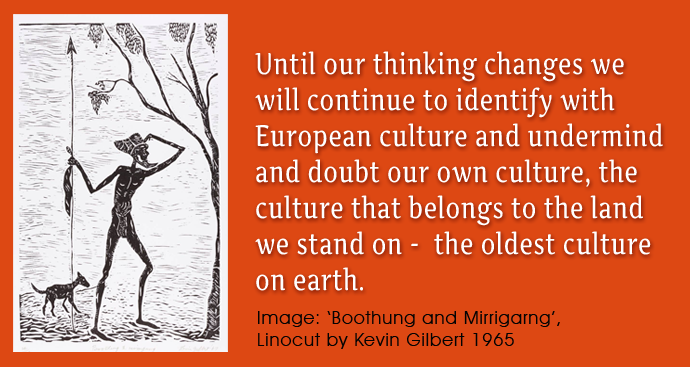DECOLONISATION

Image: 'Boothung and Mirrigarng' Lino print by Kevin Gilbert. This lino print, by the poet, artist and activist Kevin Gilbert (1933 - 1993), depicting Wiradjuri subjects, stories and heroes. It was made when the artist was in prison from 1965 using the most basic materials: lino taken from the floor and cutting tools fashioned from a used spoon, a fork, gem blades and nails. Gilbert printed the images using the back of a spoon to rub and transfer the ink onto paper.
The 1960 Declaration on the Granting of Independence to Colonial Countries and Peoples (General Assembly Resolution 1514) was a call by the international community for the end of colonialism. It led to the decolonisation of many franchise colonial states in the 60's through referendums.
Australia - a settler-colonial state, also attempted to decolonise through the 1967 referendum and other activities during the 60's.
The 1967 referendum was initiated by Lady Jessie Street. Jessie Street was the grand-daughter of squatter Edward Ogilvie - who participated in the Tabulam Massacre and built a castle near the massacre site. He also kidnapped Aboriginal children. Jessie Street was born in British India, but grew up in the castle after her grandfather died and her mother inherited it. She married into the Street dynasty which was a prominent colonial family of bankers and lawyers. Her husband was Lieutenant-Colonel Sir Kenneth Street who was the Chief of Justice of the NSW Supreme Court and the Lieutenant-Governor of NSW.
Jessie Street traveled overseas between 1950 and 1956. She spent time in England with the London Anti-Slavery Society. When she returned to Australia she recruited Pearl Gibbs. Together they helped establish a number of organisations behind the 1967 referendum including the Aboriginal-Australian Fellowship and indirectly the Federal Council for Aboriginal Advancement.
In Adelaide - at the inaugural meeting for the Federal Council for Aboriginal Advancement there was a call to change the federal constitution to allow passing laws for Aboriginies. There was also a call for "integration" of Aboriginies, and equal rights.
"Integration" is one of the methods for decolonisation from the United Nations Declaration on the Granting of Independence to Colonial Countries and Peoples.
According to the international decolonisation rules at the time, a colony can decolonise if the native people have equal rights with the colonial occupation. This isn't possible without the federal government having power to pass laws for Aboriginal peoples.
The referendum has strong ties back to England through Lady Jessie Street. The referendum gave the federal government to power to make racist laws to target Aboriginal people.
During the 60's, the states all allowed Aborigines to vote and changes to the constitution were made.
But the rules from 1960 about decolonisation changed in 1970 in United Nations General Assembly resolution 2625. This change was partly due to a international backlash against a racist white settler minority declaring independence with a Unilateral Declaration of Independence in (southern) Rhodesia in 1965. The new rules set in resolution 2625 state that the peoples of the territory (the natives) must give their consent before decolonisation can occur.
The British tried to manage this new 1970 rule in it's franchise colonies through a policy called NIBMAR (No Independence Before Majority Rule). This means that it is British policy to not decolonise franchise colonial states without getting the native population on board. Meanwhile the British continued a policy of political assimilation for settler-colonial states.
As the 1967 referendum in Australia did not involve Aboriginal consent - under the new 1970 rules it no longer met the requirements for decolonisation.
Since 1970, the Australian government tried creating various representative bodies to give consent to decolonisation via political assimilation. This includes the NAC, ATSIC and the National Congress. The problem is none of these bodies have been able to gain and demonstrate consent from the wider Aboriginal community. This is why they are discarded, they failed in their goal.
This time around - for the Uluru Statement, the newest representative body has the mandate already built in to the representative body from the start. As the Uluru Statement is a package of reform and part of a single offer - the mandate for political assimilation and independence is already built in. All the colony needs is to get Aboriginal and Torres Strait Islander people to enroll in the body and they are getting the consent for political assimilation built-in. They are also getting consent to independence through the Declaration of Recognition which is also built into the offer and is in the Referendum Council report but not spoken of publicly.
Enshrinement of the Voice to Parliament and wide participation of Aboriginal and Torres Strait Islander peoples in the voice will remove the last barrier for decolonisation of Australia. That is the true agenda behind the Uluru Statement. It will not give land back, reparations, internationally-binding negotiated terms or the truth. Just like 1967 was for the benefit of the colony, so is the Uluru Statement.
Under the laws of decolonisation, Aboriginal and Torres Strait Islander peoples collectively have effective veto over the form of independence that Australia can form when becoming a republic. "Recognition" and the advisory-only Voice are very weak proposals put out by the colony. We can do better.

